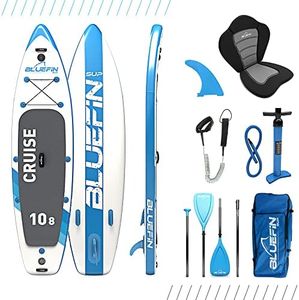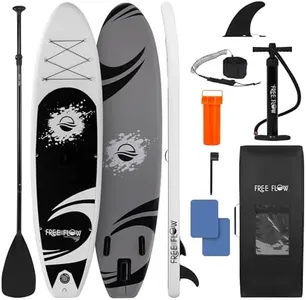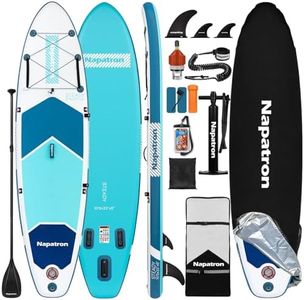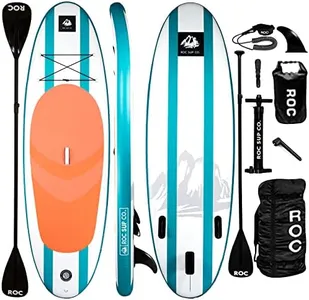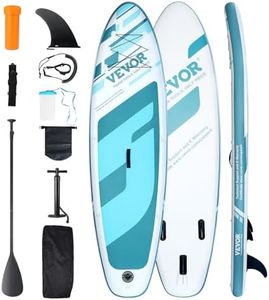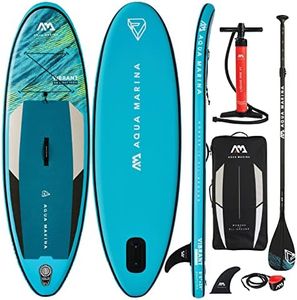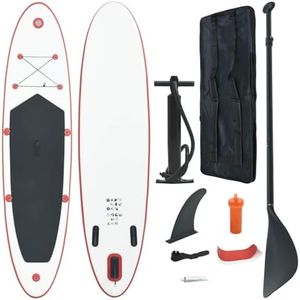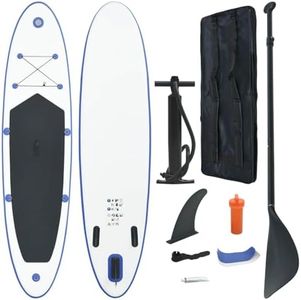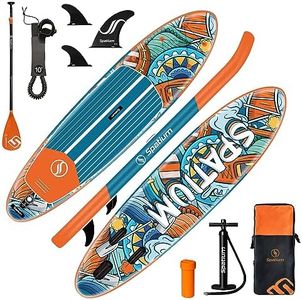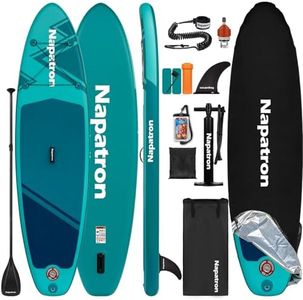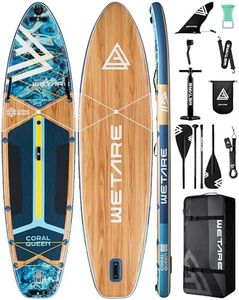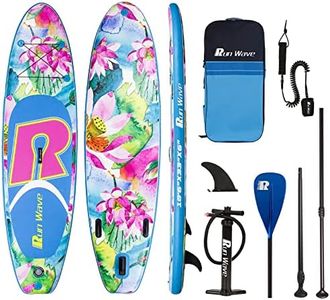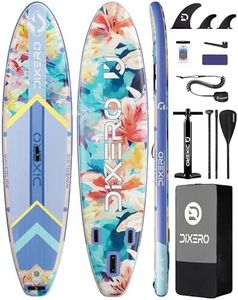We Use CookiesWe use cookies to enhance the security, performance,
functionality and for analytical and promotional activities. By continuing to browse this site you
are agreeing to our privacy policy
10 Best Inflatable Paddleboards
From leading brands and best sellers available on the web.Buying Guide for the Best Inflatable Paddleboards
Choosing an inflatable paddleboard (also known as an iSUP) is exciting, but it’s important to match the board to your skill level, intended use, and lifestyle. Think about where you’ll paddle—lakes, rivers, ocean—as well as what you want to do, like cruising, racing, or yoga. Understanding the critical features will help you select a paddleboard that’s stable, performs well, and is easy for you to transport and use.LengthLength tells you how long the paddleboard is from nose to tail, and it directly affects how the board will perform on the water. Shorter boards (around 9-10 feet) are easier to turn and control, making them great for kids or anyone looking for high maneuverability, such as in surf or for casual play. Medium boards (about 10-12 feet) are the most versatile, excelling for beginners and those using the board for all-around recreation, yoga, or leisurely paddling. Longer boards (12-14 feet or more) are faster and glide better over distances, so they’re best for touring or those who want to cover more ground efficiently. Choose the length that matches your primary activity and your own size so you feel stable and comfortable while paddling.
WidthWidth refers to how wide the paddleboard is, and it makes a big difference in stability. Wider boards (32 inches and above) are ideal if you’re a beginner, want more balance, or plan to do activities like yoga; they feel stable and reassuring. Medium widths (30-32 inches) are a sweet spot for balance and speed, offering good versatility for most users. Narrow boards (28-30 inches) are faster and more agile, appealing to experienced paddlers or racers, but they can feel tippy if you’re just getting started. Think about how much stability you want—if you’re new or prioritize balance, go wider; if you want speed and agility later on, you might choose something narrower.
ThicknessThickness tells you how deep the board is from top to bottom, which affects both the board's rigidity and how high it sits on the water. Most modern inflatable SUPs are 5-6 inches thick, providing excellent stiffness, especially when inflated correctly. Thicker boards (6 inches) support more weight, offer greater rigidity, and work well for heavier paddlers or carrying extra gear for touring or paddling with a pet or child. Thinner boards (under 5 inches) are lighter and may feel more stable for smaller paddlers, but they do flex more and sit a bit lower in the water. Consider your own weight and whether you’ll bring kids, pets, or gear to help decide what thickness you need.
Maximum Weight CapacityThis number tells you how much total weight the paddleboard can handle—including the paddler and any gear, pets, or passengers. If a board is overloaded, it will ride lower in the water and be harder to paddle and balance. If you’re the only rider, make sure your weight is comfortably below the limit. If you want to bring extra gear or a child or dog, include their weight too. Aim for a board with some margin above your total expected weight for best performance and stability.
Construction QualityConstruction quality includes the materials and methods used to make the inflatable paddleboard. Higher-quality boards often use multiple layers of PVC and advanced drop-stitch technology, which helps the board hold its shape and resist punctures. Cheaper boards might use single-layer materials, saving weight but sacrificing durability and stiffness. A board with strong construction will last longer, maintain its shape over time, and feel solid underfoot—a key for feeling confident on the water. If you want a board for frequent use or rougher conditions, focus on durability and advanced materials.
Fins and Fin SetupThe fins underneath your board help it track straight and provide stability. Most inflatable paddleboards come with a central fin and sometimes two smaller side fins. A single large fin is easier to use for beginners and in flat water, aiding straight paddling. Three-fin setups (called thruster setups) offer added control, which can help in surf or if you want tighter turns. Removable fins give you more flexibility for transport and for customizing your ride. Consider where you’ll be paddling—lakes and calm water do fine with a basic setup, but if you expect variety, more adaptable fins are beneficial.
Inflation PressureInflation pressure, listed in PSI (pounds per square inch), determines how stiff your board is when inflated. Most paddleboards recommend a range (often 12-15 PSI). Higher pressure generally means more rigidity, which leads to better performance, especially for heavier paddlers. If a board can be safely inflated to higher PSI, it’s usually more resistant to flex and feels more like a hardboard. Make sure you have a pump capable of reaching the recommended pressure. Stick with the recommended PSI for best results; under-inflated boards will sag and be less stable.
Portability and Packed SizeOne of the big advantages of inflatable paddleboards is how easy they are to transport and store. Check the board’s packed size—how small it gets when deflated and rolled up. Most come with a carry bag or backpack, but weights and sizes can vary. If you need to carry your board for long distances, up stairs, or fit it into a small car or closet, consider a lighter and more compact option. Make sure the carry bag is comfortable if you plan to take your board on hikes or public transport.
